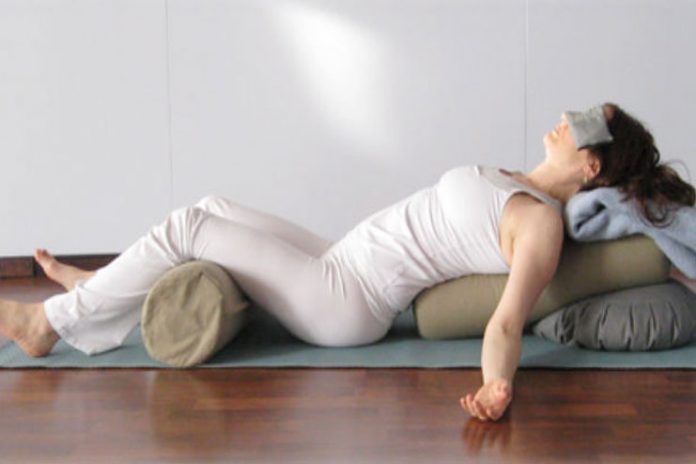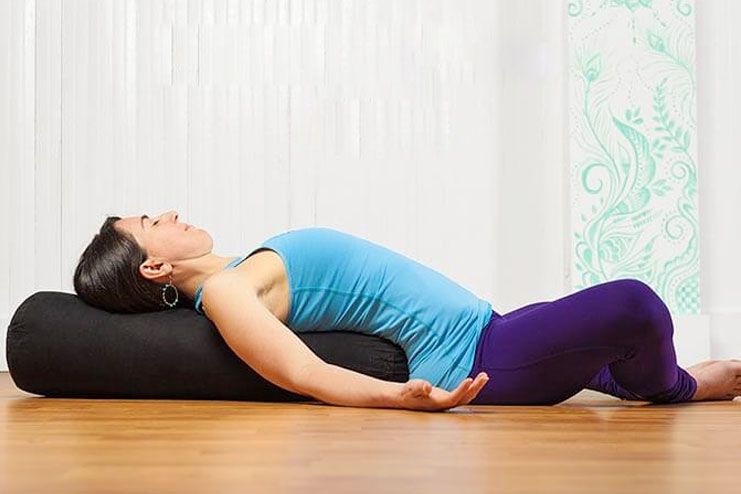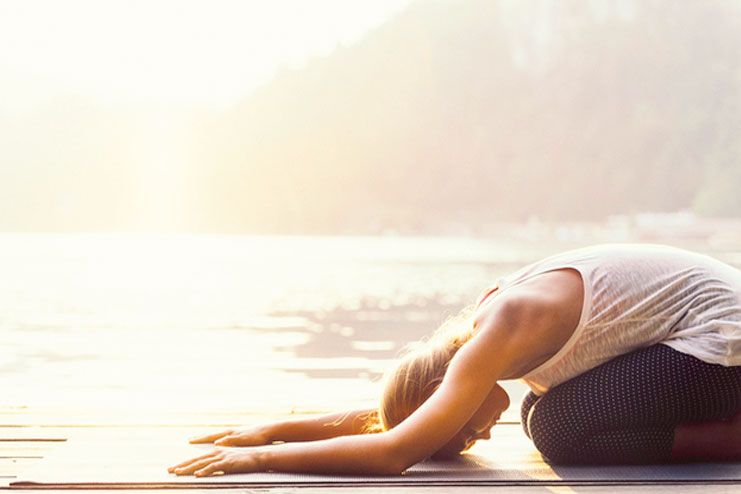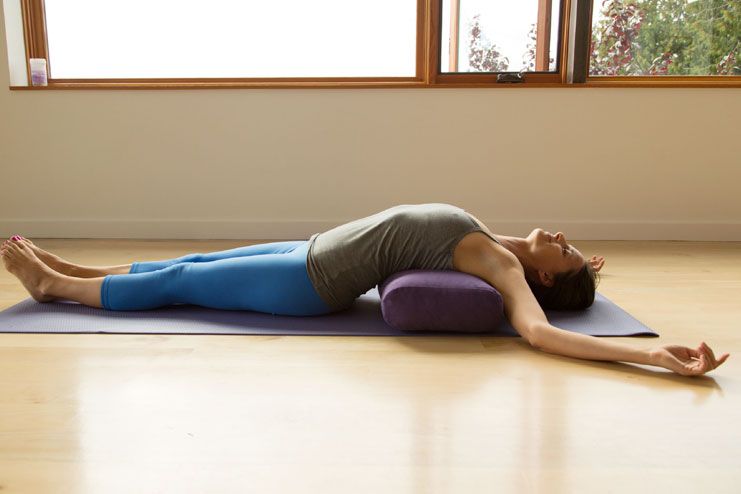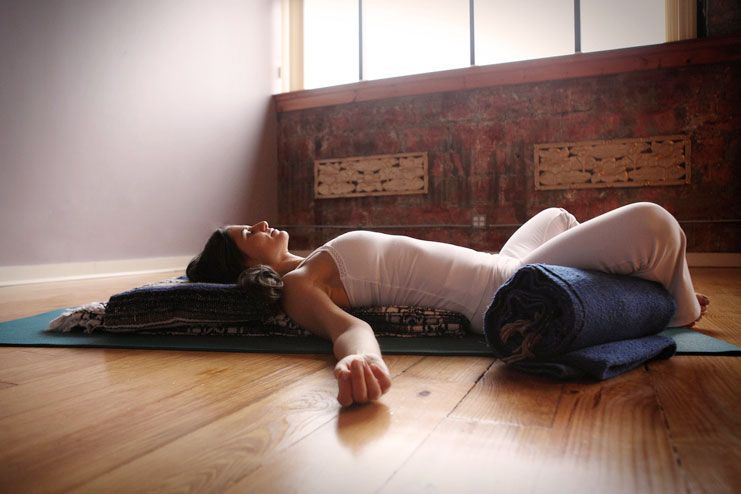Affiliate Disclaimer
Some links in this article are affiliate links. We may earn a small commission if you make a purchase through these links, at no extra cost to you. We only recommend products we find useful to our readersYoga is an ancient practice well-known for addressing various health conditions. In addition to promoting healing, yoga is highly effective in rejuvenating the mind and body and alleviating stress, which experts say contributes to numerous health issues.
Here, we provide essential information about restorative yoga, its benefits, and its role in reducing stress. Read on to discover the details and learn about various restorative yoga poses and their importance in daily life.
What is Restorative Yoga?
Restorative yoga is a form of yoga that focuses on providing emotional relaxation with the support of props. The use of props helps maintain balance while simultaneously stimulating and relaxing the body through various yoga poses.
Specific yoga poses target particular parts of the body, such as the heart or lungs, while others work on the overall development of the body.
Restorative yoga was conceptualized by one of the greatest yoga masters, B.K.S. Iyengar. He encouraged his students to use props to perfect their yoga poses, which became the foundation of restorative yoga.
One of Iyengar’s students, Judith Lasater, later popularized and spread this practice globally.
Also, Read: Finding Balance: Yoga and Meditation for Seniors’ Physical and Mental Health
What are the Benefits of Restorative Yoga Poses?
Restorative yoga poses are supported by various props, such as blocks, blankets, and bolsters, to enhance the benefits and provide greater comfort. This modified form of yoga allows practitioners to hold poses for 15 to 120 minutes. These poses help stimulate the functions of both the brain and the heart.
Restorative yoga is considered even more beneficial than sleep for releasing muscle tension, relieving joint aches, and calming both the body and mind. It is particularly effective in reducing cortisol levels, a hormone associated with weight gain, high blood pressure, and heart disease.
Regular practice of restorative yoga has also been shown to help combat depression and fatigue (R), providing better relief for cancer patients. Many yoga teachers regard it as the best form of yoga for improving sleep quality.
Sleep is essential for the body to achieve complete relaxation and recovery, particularly for the nervous system. By improving sleep quality, restorative yoga also enhances concentration, attention, and focus.
In addition to these benefits, it provides all the advantages of traditional yoga, making it a holistic approach to wellness.
Restorative Yoga Poses
Restorative yoga poses are similar to traditional yoga poses, except they are done with the support of various props. As with any exercise, it is important to begin with a warm-up, such as a Sun Salutation or a gentle Vinyasa, before practicing restorative yoga. Each restorative yoga pose should ideally be held for at least 3-5 minutes, though you can hold them for 10-15 minutes or longer if desired.
Some commonly practiced restorative yoga poses include:
1. Legs Up the Wall or Viparita Karani
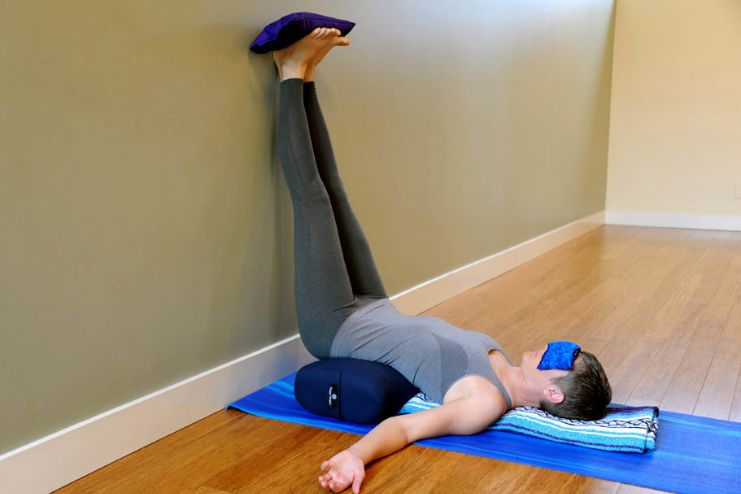
This pose soothes the nervous system, energizes tired legs and feet, and mildly stretches the hamstrings.
- Fold a blanket or pillow against the wall so it comes below your hips when you move into the pose.
- Sit sideways, as near the wall as possible, one hip touching it.
- Swing your legs up onto the wall and lower back down to the floor.
- Scooch your buttocks as close to the wall as you are comfortable. Your lower back should be resting flat against the floor.
- Rest your arms by the sides of your body, palms facing up.
- Close your eyes, breathing deeply.
- Stay in the pose anywhere from 5 to 15 minutes.
- Slowly bend your knees and roll to your side to gently come out of the post. Rest a few moments before sitting up.
2. Child’s Pose or Balasana
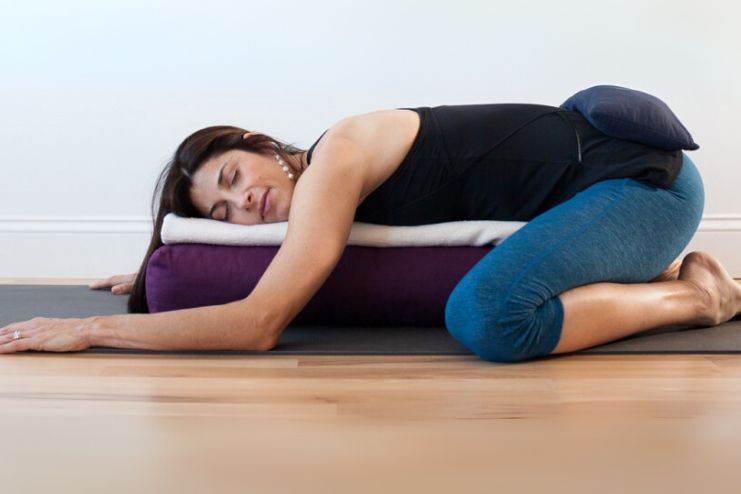
The child’s pose softly stretches the back, hips, and thighs, calms the mind, and reduces tension.
- Sit on your hands and feet.
- Bring the big toes together.
- Widen knees apart, aligning them with or wider than the hips if comfortable.
- Set a bolster or several folded blankets length-wise between the knees.
- You may also place a bolster and/or blanket below the chest.
- Exhale, lower the torso between the thighs, and rest the forehead on the mat or bolster.
- Rest the arms on the sides of the body, palm up, or extend directly forward.
- You can gently drop the shoulder blades and sink into the support.
- Close your eyes and breathe deeply.
- Stay in this position for 2 to 5 minutes.
- When you come out of this pose, gently press your way back up to a seated position.
3. Reclining Bound Angle or Supta Baddha Konasana
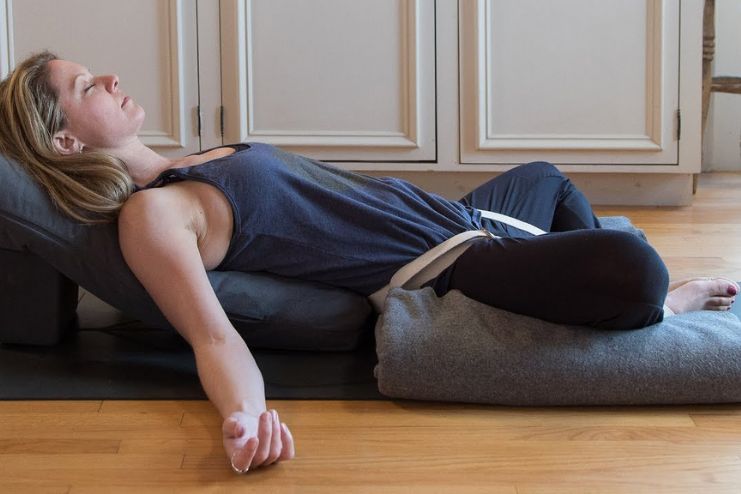
This pose opens up the hips, stretches the inner thighs, and improves relaxation.
- Sit on the floor, knees bent and feet flat on the floor.
- Place a bolster lengthwise behind you.
- Bring the soles of your feet together with your knees falling open.
- Gently rock back onto the bolster.
- Put pillows or folded blankets under the knees and outer thighs for added support so that the legs feel relaxed.
- Arms rest at their sides with palms facing the sky.
- A small pillow can go beneath the head for comfort.
- Close your eyes and breathe deeply.
- Stay in this pose for 5-10 minutes.
- To come out of this pose, carefully bring your knees together and roll onto your right side. Rest a moment here before sitting up.
4. Relaxation or Savasana
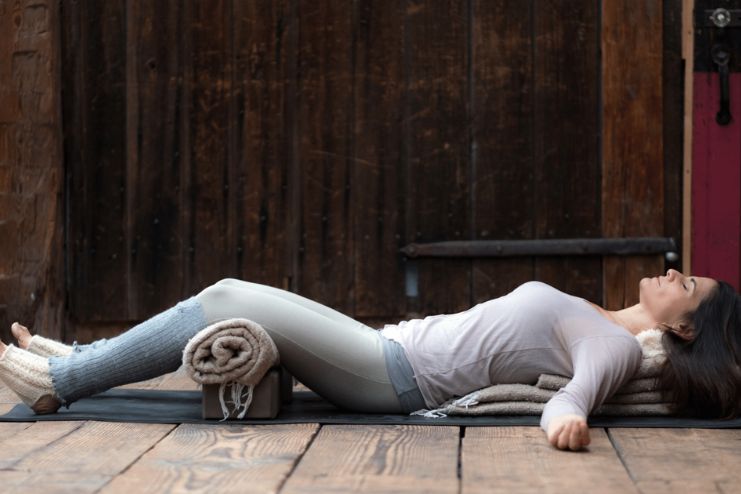
This pose brings deeper rest and relaxation. It enhances comfort and warmth.
- Lie flat on your back on the mat.
- Place a pillow or folded blanket under the head for support.
- Beneath the knees, place a bolster or rolled blanket to support the lower back.
- Rest the arms beside your body, palms opened.
- Slightly tuck the shoulder blades beneath you to let the chest open.
- Close the eyes and soften the face.
- Be aware of the breath and let it find its natural flow.
- Let all your tension go.
- Hold the pose for 10-15 minutes.
- To come out of this pose, slowly, begin moving your fingers and toes. Gently roll to the right side and rest a while, then slowly stand up.
Also, Read: Sunday Stretch: Relaxing Recovery Yoga
Props Used In Restorative Yoga
It is important to use a variety of props while practicing restorative yoga. Always ensure the props are the right size for your body to ensure comfort and effectiveness during the poses. Even a half-inch difference in prop size can make your entire practice uncomfortable.
- Blankets
Blankets offer support, warmth, and comfort in restorative postures. They could be folded to provide height under the hips, knees, or head so the body is perfectly aligned and relaxed.
- Bolsters
Bolsters are traditionally used under the back, knees, or head for comfort and warmth in postures such as Supta Baddha Konasana (Reclining Bound Angle Pose) or Savasana (Corpse Pose).
Bolsters are long, firm cushions that support the body in various poses. They open up the chest, maintain the spine curve, and enable deep relaxation.
- Blocks
Yoga blocks provide stability and height adjustment for the body in various postures. They can support the spine, legs, or arms for proper alignment.
Blocks are often used to support the hips, knees, or head in elevating a portion of the body, creating a more supportive position in postures such as Supta Padangusthasana (Reclining Hand-to-Big-Toe Pose).
- Straps
Yoga straps are used to enhance the deeper stretch and increase flexibility. This is especially useful for you if you are unable to touch your feet or hands in a particular pose. The straps can be looped around the hands or feet to allow proper alignment, and you can stretch deeper while in poses such as Forward Fold or Supta Baddha Konasana.
- Chairs
Chairs can support patients with mobility issues or those who prefer a more accessible version of restorative poses. Chairs are usually used for people to perform restorative stretches in some poses, such as Chair Yoga or Seated Forward Fold, so that their practitioners are supported and are allowed to feel comfortable.
- Eye Pillows
Eye pillows are used to relax the eyes and face and, consequently, to soothe the nervous system. They are often placed on the eyes in Savasana or during meditation to block out the light and give one a deeper sense of relaxation.
- Cushions or Pillows
Cushions or pillows offer extra support and comfort for areas such as the neck, knees, or lower back while attempting certain poses. It can be placed under the knees, head, or back to remove tension and correct the posture in asanas such as Legs up the wall or reclining hero’s pose.
Can Restorative Yoga Poses Reduce Stress?
Yes, indeed. As mentioned earlier, restorative yoga poses help promote good quality sleep and provide complete relaxation. This practice is effective in reducing stress both in the mind and body.
Restorative yoga also activates the parasympathetic nervous system, also known as the rest-and-digest system. This system is beneficial for relaxing the gastrointestinal tract and slowing down the heart rate. It can also help reduce blood pressure.
To fully experience the benefits of restorative yoga, follow a well-structured sequence. Creating a healthy restorative yoga routine can help alleviate various health conditions and enhance overall well-being.
Conclusion
Restorative yoga is one of the best forms of alternative medicine, offering a wide range of health benefits. Its poses help build physical strength and provide mental relaxation.
It is a modified version of traditional yoga, performed with the help of various props to enhance comfort. This allows you to hold poses longer, providing a deeper stretch.
As a modified form of yoga, you can also make restorative poses more challenging by adding your own variations.
For example, in poses like Balasana (Child’s Pose), you can increase the stretch of your arms and upper body for additional benefits. You can even lift your buttocks higher, away from your heels, to intensify the stretch.
-
Aug 2017Written by Prajakt K
-
Feb 2025Edited by Lakshmi Gayatri
In this Article













